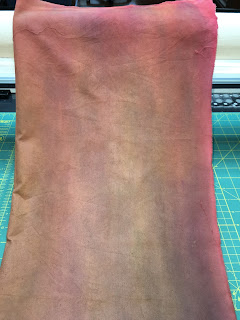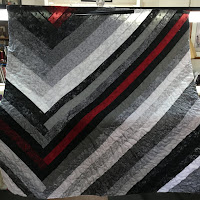My brother is a retired CalFire firefighter. My dad drove the boy up to Potter Valley in Northern California the night he graduated from San Marcos High School to begin working the summer as a summer job. He never got to go to the graduating party or, more importantly, to get into trouble the night of graduation. Needless to say, my dad felt this action was very important.
Forty-some-odd years later, he retired from CAL-FIRE (formerly the California Division of Forestry) and I promised him a quilt. All these years he said he always wanted an "original work of art" for his house. So, I decided I would make him a nice quilted wall hanging. Easy, right? Don't think so.
Shawnee always seems to difficult things up. I don't know why - it justs seems to be what I do. I take the simplest of tasks and complicate it beyond words. So, let me tell you how the infamous FIRE QUILT came into being - it's a good story of a quilter and her brother.
See, my brother, Brian, has always sent us photos he took while fighting fires. Some pictures of his colleagues working, others he got friends to take of him doing this and that. One particular photo has been my favorite showing him in front of a fire. I told all my friends one day I would make that into a wall hanging for my brother when he retired. Years I searched high and low for good FIRE fabric. I saw lots of fire fabric, but most of it was novelty fabric and it never achieved what I wanted the quilt to say. Then, there was the content of the quilt - well - I come and go on that subject.
Finally, after my brother retired, I decided to try my hand at dying fabric to get some decent fire fabric. Some worked, some - not so much. (Some of my efforts are on my Pinterest page.) Ended up with one pretty good piece, but I had no idea what I was going to do with it. At one point I thought I would just frame the fabric piece and let him hang that as "modern art." That hung on my bedroom door for a year or so - no forward movement on either finishing it or making it into something.
One day I got the great idea to make a Convergence quilt similar to Ricky Timms. I can't say I am in love with it, and it was easy enough to do, but it didn't thrill me. Then, one night as I was thinking about the convergence quilt as I went to bed, I must have dreamt about the FIRE QUILT. I got up the next morning and sent my brother an email asking if I could cut up the FIRE FABRIC panel I gave him, but kept here to finish. His answer was typical: "I don't care what you do with it." Duh. Doesn't he know NEVER say that to a quilter?


This was a beautiful piece of 'accidental art,' done for my brother and it had all the elements of fire, ashes, burned trees, etc. all in this dyed piece of fabric. He may not have cared, BUT I CARED! What if I made a terrible mistake and cut up the one piece of fabric that came out decent? What if I ruined the whole thing? what if, what if? I was a mess, but I decided to pair up a great piece of batik and the 'fire fabric' and cut it into a convergence quilt. Making that first cut terrified me.
What I decided was I would do it. If it was ruined, perhaps I could make another piece that looked like it. He would never know the difference (I would, but he wouldn't.). Regardless, I calculated the size of the piece of dyed fabric and then calculated the size of the pieces I was going to cut. I was almost sick cutting a stupid piece of fabric, but I did.
Convergence quilts are very simple. Whatever size strips the focus fabric is cut, the accompanying fabric is cut the same from the opposite side. The strips are sewn together attaching the largest focus fabric to the smallest accent fabric all the way across until they are all sewn together as a new piece of fabric. Dig around until you find a good border - and Ta Da! a quilt is born!
Not so quick (or easy). What in the world do you pick as a border? I thought I was going to go crazy over that dilemma. I think I picked out a good piece of batik. It was pretty O.K. Interesting. But I still wasn't in love with it. I sent my brother a picture of it and he named it the CEDAR FIRE. This was a big fire in San Diego County in 2003 which destroyed more than 1800 homes and more than 200,000 acres. Three people were killed and one firefighter died. I lived in Poway, California, and my brother came down from Northern California to help fight the fire. It took almost 3 months before the fire was considered "contained." This fire was horrendous. I lived in Poway, near Rancho Bernardo, California, and we were all traumatized for more than a week. The smoke was heavy and the ashes clogged our swimming pool filters, car filters, windows, and essentially everything!
As I loaded the CEDAR FIRE onto my Gammill, I prayed I wouldn't mess it up. I had no idea what I was going to do other than perhaps make a few "flame" quilt patterns on it. Let's face it - this was only a strip quilt, plain and simple.
QUILT SOLUTION:
Remember a convergence quilt is actually a simple quilt. I think the secret of quilting a simple quilt can be to keep the quilting simple, but add interest and depth. I figured a variety of threads mixed together or even on top of each other
could be one way to go. I have a bad habit of being heavy-handed with thread, so I needed to tread lightly.

I found a website that actually talked about the analytics of fires. I know, who would write something on their website about how fires burn, move, and look? Either an arsonist or a firefighter, ha! But, I actually sat and read it all and took notes. Figuring flames travel upward, I actually started the quilting at the bottom of the quilt and moved my quilted flames upward I quilted 'fire flames' using a Superior trilobal polyester as a base over the body of the quilt - but not the borders. Not a heavy quilting, and actually that looked quite nice.

The next step I needed to convey the
feeling of fire, so I used a Superior Metallic copper-colored thread. Again, I created more flames going from the bottom up to the top. Lastly, I added a dash of black metallic here and there as flames have black on the outsides (or so the expert says). Looked good - so I stopped. I used one of my friend's ideas to create swirls on the borders to represent the winds created by fire storms using Superior Fantastico and allow the flames to creep into the border area and the wind quilting to creep into the flame area. That was all there was to it. Nothing fancy. No spectacular free motion quilting designs, just simple flames and using great Superior metallic and Fantastico threads! Anyone can do this and the result is an exceptional quilt I hope my brother enjoys for many many years!
Future Fire Quilts: Valley Fire and Rim Fire (Yosemite, CA)










